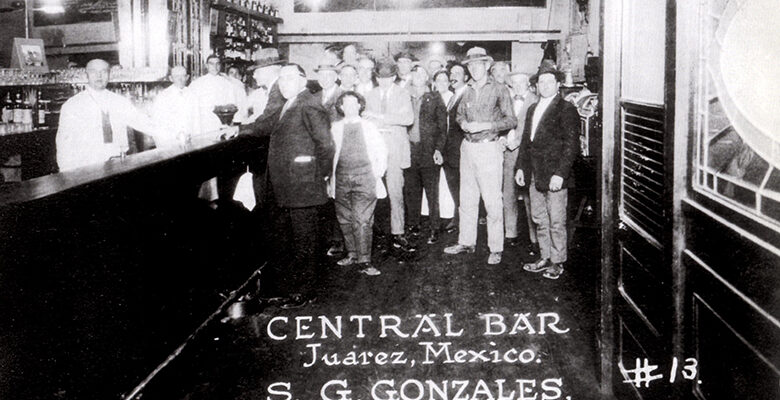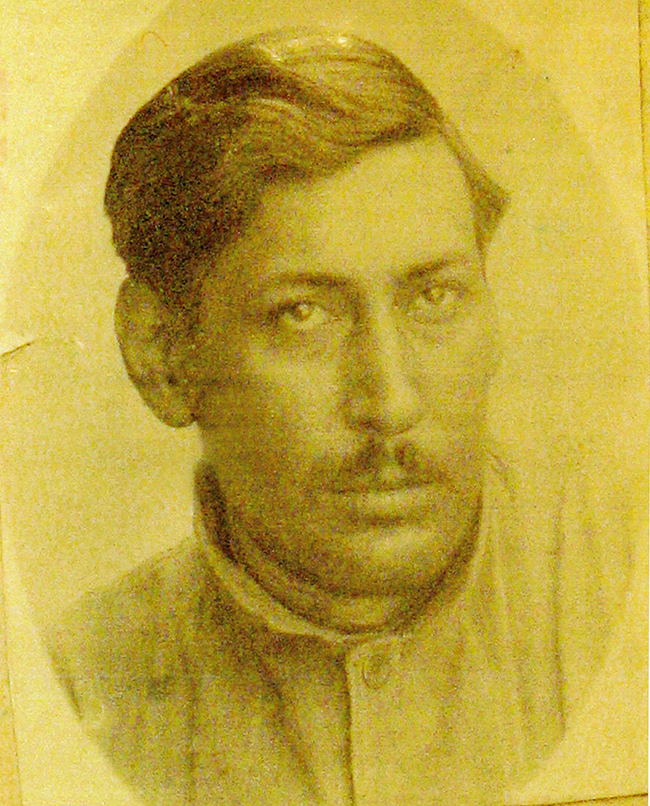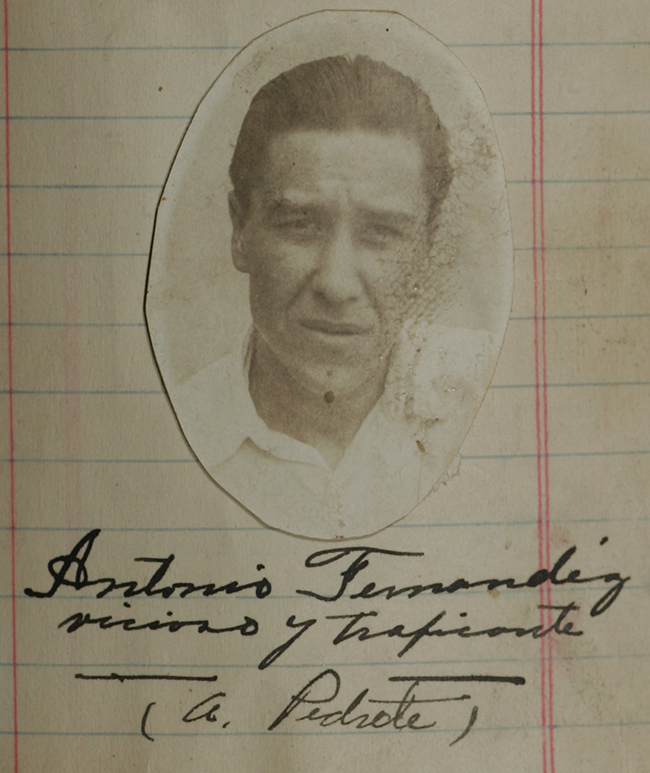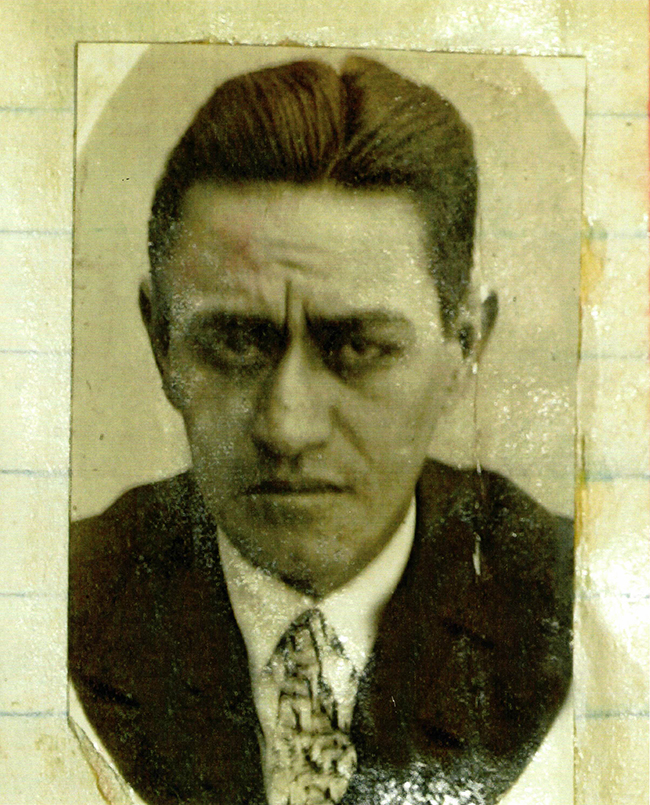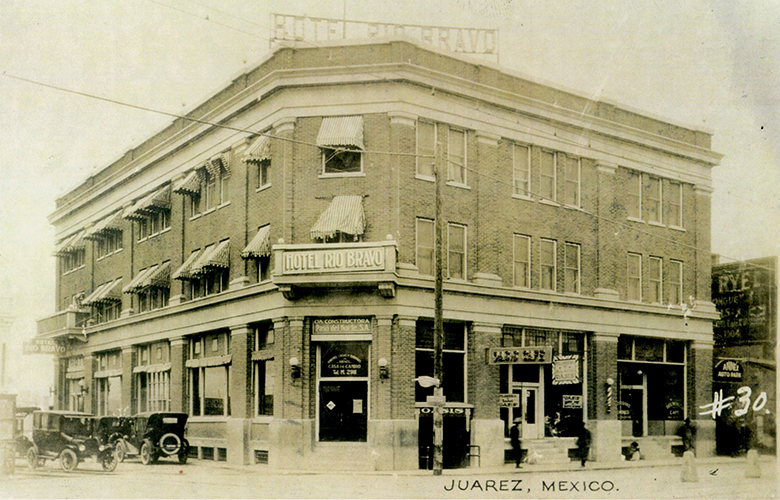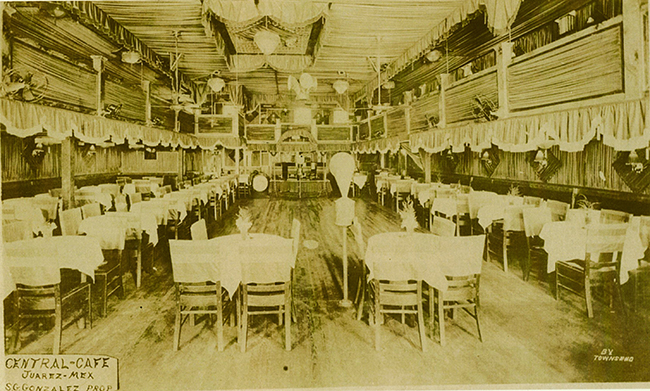By Bob Chessey
This is Part 2 of a three part series. You can read Part 1 here.
The Valera Affair
One year later Harry Mitchell was connected again with drug sales, but this time the association was not obscured in a confidential government document but printed on the front page of the El Paso Times. On the night of Wednesday, April 28, 1926 Ramon Valera left the Mint Bar and was followed by two Juarez narcotic agents, Jesus Chacon, and Roberto Rascon. Valera began running and when apprehended and searched he was found to be in possession of a small quantity of morphine. Police charged that the narcotic sale had occurred inside the Mint.ii
The governor of the state of Chihuahua recently had ordered that “any saloon suspected of being connected with the sale of narcotics be closed, even though the proprietor be ignorant of the transaction.”iii As a result Juarez Mayor Alberto B. Almeida executed an order and, at 10 A.M the following morning, the Mint was shuttered.
Nonetheless, by 6:30 that evening the business was back open and operating. Harry Mitchell and Mayor Almeida had met between the closing and reopening with Harry assuring the mayor that he had no knowledge that anyone bought or sold narcotics in his bar. At the same time Harry Mitchell “dissolved” his partnership with Enrique Fernandez and was allowed to apply and receive a permit for the business in his name only; these actions led Almeida to absolve Mitchell from being involved in the Valera affair and allowed the Mint to re-open. iv
In addition to Valera’s connection to Mitchell and the Mint, complicating Fernandez’s continuing the partnership, was Enrique Fernandez’s brother Antonio. Antonio headed Enrique’s narcotic operation and, a month and a half earlier, had been arrested on a major narcotic violation.
Antonio’s arrest exposed a major narcotic ring operating in Juarez which, during the previous two months, had flooded Juarez with opiates. A prime selling location for the traffickers had been Liberty Hospital in Juarez where, after having been arrested, many narcotic addicts had been court ordered to address their addiction.
The arrest of Antonio Fernandez and his two associates, Salvador Duran and Salvador Varriendoz, occurred during a police raid at Antonio’s residence. At the time of Antonio’s arrest officers pulled 19 packages of narcotics from inside his pockets. Juarez police identified Antonio Martinez as “the king of morphine.”
After arresting Antonio Fernandez, Duran, and Varriendoz, plain clothes officers waited in the front room while uniformed police hid in several back rooms. When callers knocked on Antonio’s door, they were asked why they had come to the address, when answering that they were wanting narcotics, the “visitors” were immediately taken into custody. In total, 12 people were arrested with seven of the arrestees identified as drug vendors belonging to Fernandez’s crime ring.v Two days later another two people knocked on Antonio’s door seeking narcotics and were arrested.vi
The rekindled attention on the brother of Mitchell’s partner would have applied additional stress and pressure on Harry. However, Enrique’s political connections appear to have deftly resolved the closing of the Mint.
At the time Valera was arrested Enrique Fernandez was out of Juarez; but the crime boss would have been immediately informed and begun working his political contacts. The events that followed appear to have been legal finagling by both Mitchell and Fernandez to avoid the closing of the Mint and resurrect their partnership.
Five months after the Juarez mayor had granted the Mint’s reprieve, on September 18, 1926, an advertisement for the Mint published in the El Paso Post read, “At the Time This Ad Is Being Written THE MINT CAFÉ Is Closed, Due to Unforeseen Circumstances, but We Hope to Be Open to WELCOME THE V.F.W. At Your Encampment HARRY MITCHELL.”vii Three days later, September 21, an advertisement in the El Paso Times announced a new bar, THE CHAMP, a “Sportsmen’s Headquarters,” and added, most importantly, “FORMERLY THE MINT.”viii The owners of The Champ are listed as “Curley Joe” Morgan and Jesus H. Cuaron. At this point neither Mitchell or Fernandez appear to have owned or operated the Mint.
One month later Harry Mitchell announced that he would be opening a new bar and restaurant, the Casino Club. The business would remain on Ave. Septiembre de 16th in the basement of the Rio Bravo Hotel. Mitchell assured a reporter that his new venue would be ready to open its doors and serve the public in seven or eight weeks.ix
The public never received the opportunity to patronize the Casino Club. On Christmas Eve 1926 an advertisement in the El Paso Times announced that the new Mint Café would open that evening. The ad proudly displayed the names of the owners: E. Fernandez and Harry Mitchell.x Harry and Enrique had succeeded in regaining possession of the Mint. The reunited partners had invested over $40,000 ($709,348 in 2023) in their new venturexi serving not only beer, wine, and a range of liquors, but also presented a menu of fine dining in direct competition with Severo Gonzalez’s Central Café.
During the reign of the US Volstead Act the addresses of the tourist bars in Juarez often displayed peripatetic tendencies and the reopening of the Mint was no exception. The second incarnation of the Mint did not receive patrons at its previous location, close to Lerdo Street between O’Brien’s Bar and the Central Café; or, as Mitchell had announced previously, in the basement of the Rio Bravo Hotel, instead, the establishment moved to the immediate west side of The Lobby Bar#1. The new building was the familiar image in front of the Mint that is often reprinted in articles and books discussing the cafe, Harry Mitchell, or Enrique Fernandez.
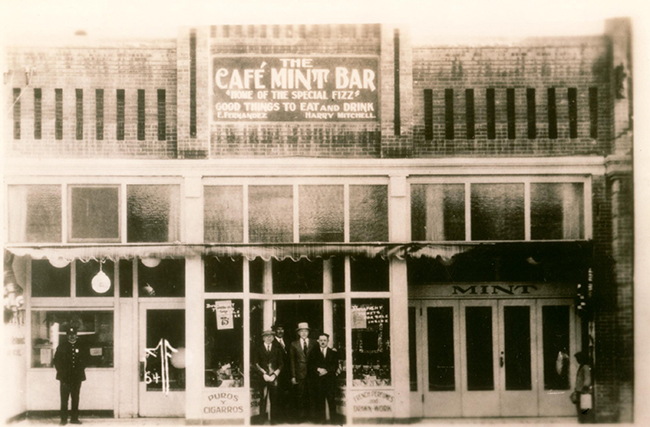
(HISTORICAL SIDE NOTE: A commonly held urban legend, perpetuated on an internet site listing no citation for the claim, erroneously asserts that Pablo “Pablote,” known for his brawn and bullying, and his wife Ignacia “La Nacha,” smart and ambitious, Gonzalez, took over Juarez narcotic trafficking by massacring 11 Chinese opium traffickers in the city.xii The truth is less dramatic and sensational. The married couple had been selling narcotics for Fernandez’s organization before Antonio’s arrest when a decision was made to put Pablote forward as a proxy and a front to deflect attention away from Antonio and Enrique Fernandez. After Antonio’s March 15, 1926, arrest with 19 packets of morphine in his pocket, and his identification as the “king” of Juárez narcotic dealers,xiii Enrique went into damage control and must have called in favors and talked to contacts and “friends” in the Juarez Police Department because seven days after Antonio’s arrest, March 22, 1926, and having been labeled as “king” of Juárez narcotic dealers, Pablo Gonzalez was suddenly identified as the leader, and not only for dope, but also the head of the Juárez underworld;xiv the masquerade perpetuated until Pablo’s death in a Juarez whorehouse gunfight in 1930. In the 1930’s his widow La Nacha rose to become the dominant narcotic trafficker in Juarez, a position she maintained until her retirement in the early 1970’s.)
Enrique Fernandez would continue to be linked to narcotics, including an August, 1928, 2 am gunfight with a Mexican federal agent inside the lobby of the Rio Bravo Hotel; neither man was killed. The agent had been sent from Mexico City to investigate Fernandez’s criminal enterprises.
On Wednesday, November 21, 1928, three months after Fernandez’s highly publicized hotel shootout, Harry Mitchell announced that he had purchased Enrique Fernandez’s share of the Mint Café and terminated their partnership. Five days later, Harry Mitchell sold the restaurant and bar to F. O. Mackey, one of the owners of the D. & M. Distillery in Juarez. xv Mitchell informed an El Paso newspaper that, “I am going to rest and then go back into business.”xvi It is not known if “back into business” inferred a restaurant in El Paso, in Juarez, or a Café in another Mexican border town not associated with Enrique Fernandez.
Nonetheless, Harry Mitchell did not rest long nor establish a new bar or restaurant in Juarez. Instead, a month and a half later, the veteran barman repurchased the Mint and continued operating the business as its sole owner.xvii
Fernandez’s exit from the Mint partnership was presumably the impetus for the gangster to open and substitute his two shoe stores in Juarez for the Mint Café as his legitimate front businesses.xviii
Following the 1926 arrest of Ramon Valera, Harry Mitchell steered clear of any association with narcotics. Until 1931.
Narcotic Possession Charge
After closing the Mint shortly past midnight on Friday, August 28, 1931, Harry Mitchell was given a ride to his home in Juarez by Rogelio Sanchez, one of the café’s bartenders. Between12:30-1 am Friday morning the men parked in front of Mitchell’s residence, 206 Calle Lerdo, and were immediately swarmed by Juarez police officers who removed both passengers, and transported the pair to the police station. After Mitchell and Sanchez were driven away their vehicle was searched. Allegedly an ounce of heroin was found inside the car where Harry Mitchell had been sitting.xix
After his arrest Mitchell brazenly proclaimed, “The charges against me were absurd. I have never been connected in any way with any such (narcotic) traffic.”xx Though Mitchell had been named by the US Consul in Juarez in 1925 as a suspected higher up in narcotic trafficking, that allegation had not been publicly released, however, his business partnership with a drug smuggler would have been known.
After being charged with trafficking narcotics, Mitchell and his bartender’s case was handed over to the District Attorney. Upon reviewing the evidence, the DA reduced the charge to possession of narcotics and turned the case over to the federal health office in Juarez. Dr. Alberto Jacqueminot, ruled that the presenting evidence was insufficient and dropped all charges against each man.xxi
But Harry Mitchell viewed neither his release from jail nor the quashing of the charges against him as putting the humiliating arrest behind him. Among the El Paso County Historical Society’s archives is the Harry Mitchell collection, that holds an undated, three-page legal size document addressing his arrest, likely translated from Spanish, titled: “MEMORANDUM relating to the history or antecedents of the affair of Harry Mitchell, and showing how he was molested and persecuted by the State Government.”xxii The “State Government” of the title is Chihuahua, Mexico.
Harry Mitchell had filed an application, but never obtained, Mexican citizenship and remained a British subject.xxiii Following his arrest Harry Mitchell contacted Robert E. Owen, British Vice-Consul, the person who likely composed the memo delivered to the Chihuahua State Government.xxiv The Memorandum spells out a litany of complaints that Mitchell contends were hostile acts targeting him and implemented at the behest of a business competitor.
The document charges that police “discovered a small packet containing a portion of heroin, but that the powder was principally composed of bicarbonate and flour,” resulting in Mitchell and his bartender being confined “in a filthy department of the jail.” Beginning at an early hour the following morning, Mitchell’s lawyer made diligent efforts to obtain a hearing of the case before the Advocate of the District Court, but without success, adding, “the Public Ministry (Public Prosecutor) summoned the parties who intervened and nearly all of them hid themselves to avoid testifying in the case.”
Because the officials evaded direct questioning, and the expiration of the time that Mitchell and Sanchez could be held legally, the Public Prosecutor dropped all charges against the men.
The accusations in the memorandum leveled against Juarez officials were not restricted to Mitchell’s narcotics charge, that grievance only occupied one-half of the first page of the three-page filing. The memo describes a pattern of harassment and abuse of power by city and state officials against Harry Mitchell and the Mint at the instigation of a business competitor.
On the day of his narcotic arrest Mitchell had received an order from the city that the Mint Café’s kitchen walls were in danger of falling and needed to be torn down and replaced. Mitchell immediately secured the necessary permit from the Department of Public Works, hired contractors to work all that day and night to demolish the walls and achieve compliancy. Then the Juarez Mayor ordered that all work at the Mint be halted.
The owner of the building housing the Mint, Mariana Ochoa, also had been served an order to demolish and rebuild the wall. Ms. Ochoa requested a suspension of the orderxxv; a request that was first granted temporarily and then received permanent status.
The memo’s catalog of malfeasance continued, stating that on September 12 Harry Mitchell had “positive information that the mayor had received an order by telephone to close the ‘Mint Dafe’ (sic) permanently, intelligence which he (Mitchell) learned casually.” Mitchell requested, and was granted, a request for suspension of the closure order. Thirty minutes later a mysterious fire broke out in the Mint Café. The Juarez Fire Department was called to the café and even though the inferno was igniting the surrounding buildings the firemen “confined themselves to gazing tranquilly at the blaze, stating that they had no masks and were without a sufficient supply of water to extinguish the fire.” In desperation Mitchell telephoned the El Paso Fire Department, who raced across the bridge and extinguished the blaze.
Following the fire, the document asserts, “public opinion pointed to the Governor of the State, as the agents executing the order to burn, as the persons responsible for this criminal action.” Blame was also directed toward the Second Judge of Juarez’s District Court, who initially believed that Mitchell and Sanchez should receive a fair hearing, however, after Mitchell and Sanchez request for an amparo (writ of protection against charges) had been filed the jurist’s position wavered and he allegedly shared with a “reputable person” that the submission for relief would be best brought before the Governor of Chihuahua, Andres Ortiz. While admitting Mitchell had no proof, the memo states that the Judge “has been receiving money from the Governor of the State to pigeon-hole all matters in which he may be asked for protection against the arbitrary acts and abuses of Ortiz.”
The memorandum then targets the core of the legal problems confronting Harry Mitchell:
“It is also in point here to make clear the fact that the merchant Severo (sic) G. Gonzalez initiated the persecution against Mr. Harry Mitchell through Attorney Fausto Miranda, who is well known for his bad faith and his dirty and unworthy proceedings in the negotiations which he handles. They paid a sum of money to the Governor and he ordered the Mayor to execute the infamous persecutions to which reference has been made. They also took possession of sixteen hundred dollars which Gonzalez had consigned in favor of Miss Mariana Ochoa in the Civil Court, as payment of rents for a property contiguous to the ‘Mint Café, a house which Severo (sic) G. Gonzalez could not succeed in renting, this being the principal cause of the ill-will and unbridled persecution directed against Mr. Harry Mitchell, who Gonzalez fears on account of his business competition.”
In addition, the memo contends that the Solicitor of the Public Service, “undoubtedly under the instruction that he has received from the Procurator of Justice” created obstacles to prevent Harry Mitchell from collecting the insurance from the losses in the Mint’s fire.
The concluding paragraph argues that Harry Mitchell was the target of “official persecution” not only due to personal and/or competitive conflicts between Mitchell and Gonzalez, but also that the Governor of Chihuahua erroneously assumed that Mitchell had financed an ad in an El Paso newspaper criticizing Ortiz, as well as Harry Mitchell having committed “the crime of being the friend of Mr. Enrique Fernandez.” Neither of these issues had been mentioned previously in the Memorandum.
Eleven days after Mitchell’s arrest for heroin possession an official letter composed by the American Consul in Juarez brings full circle the saga of Harry Mitchell’s connection with narcotics. On September 8, 1931, William P. Walker, the American Consul in Juarez, wrote a letter of reference for Mitchell to the United States Immigration authorities in New York, New York. The crux of Consul Walker’s vouching reads, “Mr. Mitchell is a well known and high standing business man of this community. He has been issued a non immigrant visa by this office, and I have also availed myself of the privilege of giving to him this letter as further proof of the intentions of the trip and of his good standing at Ciudad Juarez, Chihuahua, Mexico, and El Paso, Texas.”xxvi
The Narcotic Question
The three incidents referenced in Part 2, Consul Dye’s “higher up” allegation, Ramon Valera’s arrest outside the Mint, and Harry Mitchell’s arrest for heroin possession, all lead to the question, was Harry Mitchell complicit in narcotic trafficking or sales?
Curiously, though all the above incidents have been mentioned in previous research, questioning any role or connection of Mitchell’s in the narcotics trade has been tacitly dismissed. However, sometimes it is fun to kick the rock over and see what’s crawling around underneath.
Consul Dye’s Dispatch
The most damning implication cast is Consul Dye’s 1925 accusation of Mitchell being a suspected “higher up” in narcotic trafficking in Juarez, a serious charge to be levied and committed to a federal document.
Gifting Harry Mitchell a dismissal of any involvement in trafficking, believing that it was merely guilt by association because Fernandez was Mitchell’s business partner in the Mint, is built upon a false assumption. Dye issued the accusation on April 25, 1925, however, as shown above, on September 26, 1925, five months after Dye’s accusation, Mitchell was still the sole owner of the Mint Café. Enrique Fernandez did not become a business partner in the Mint until an unknown date between September 26, 1925 and March 6, 1926.
Dye noticeably placed Harry Mitchell’s name at the top of the list of suspected “higher ups; perhaps by coincidence, perhaps not. Surprisingly, the list of suspects imply that Enrique Fernandez was not as well-known to Consul Dye as both Enrique and his brother Antonio have their last name misspelled as “Hernandez.”
When people think of drug traffickers, they picture a person selling and handing the narcotic to the purchaser. Higher ups distance themselves from street sales, generally they invest cash into narcotic deals and transactions. It is important to recall that Dye never claimed that Harry Mitchell personally sold narcotics, Dye submitted that the bar owner was a “higher up” in trafficking drugs.
Mitchell and Fernandez were ambitious. It is possible that after opening the original Mint that Mitchell aimed to offer a fine dining establishment. The initial investment to upgrade would have required a substantial influx of cash to purchase, and then maintain, the necessary overhead of a new building, extra staff, and a higher quality of food until the restaurant sustained itself.
Nonetheless, Dye provides neither a reason nor explanation on how and why he reached that conclusion, No other accusation by a US official accusing Mitchell of trafficking has been found.
This is Part 2 of a three part series. You can read Part 1 here.
i“Dry Agents Fail To Locate Driver Of Liquor Truck,” El Paso Times, August 26, 1922, p. 3; “Mitchell Rum Case Appealed By Government,” El Paso Times, November 6, 1925, p. 2.
ii“Juarez Mayor Closes Saloon,” El Paso Times, April 30, 1926, p. 1.
iiiEl Paso Times, April 30, 1926, p. 1; “Oust Partner, Reopen Mint,” El Paso Post, April 30, 1926, p. 1.
ivEl Paso Times, April 30, 1926; El Paso Post, April 30, 1926.
v“Juarez Narcotic Ring Broken Up,” El Paso Times, March 16, 1926, p. 3; “Juarez Police Get Three Suspects in Narcotic Warfare,” El Paso Herald, March 16, 1926, p. 12; “Juarez Police Seize Morphine; 12 Are Arrested,” El Paso Herald, March 17, 1926, p. 14.
vi“City News in Brief,” El Paso Herald, March 19, 1926, p. 9.
viiAdvertisement, El Paso Post, September 18, 1926, p. 17.
viiiAdvertisement, El Paso Times, September 21, 1926, p. 6.
ix“To Open New Juarez Café,” El Paso Post, October 26, 1926, p. 8.
xAdvertisement, El Paso Times, December 24, 1926, p. 5.
xi“Harry Mitchell Now Sole Owner of Juarez Café,” El Paso Herald, November 21, 1928, p. 3.
xiiDrug trafficking (uacj.mx) accessed March 7, 2023.
xiii“Juarez Narcotic Ring Broken Up,” El Paso Times, March 16, 1926, p. 3; Juarez Police Get Three Suspects in Narcotic Warfare,” El Paso Herald, March 16, 1926; “15 More Arrested in Juarez Drug Drive,” El Paso Times, March 17, 1926, p. 10; “Juarez Police Seize Morphine; 12 Are Arrested,” El Paso Herald, March 17, 1926.
xiv“Smuggling Ring Is Broken in Juarez,” El Paso Herald, March 22, 1926, p. 1.
xv“Juarez Saloon Operator Shot in Pistol” Duel, El Paso Herald, August 25, 1928, p. 1; “Buys Interest in Café,” El Paso Evening Post, November 21, 1928, p. 13; “Café Sold,” El Paso Herald, November 26, 1928, p. 1.
xvi“Announce Sale of Mint,” El Paso Evening Post, November 26, 1928, p. 2.
xvii“Harry Mitchell To Again Operate Mint,” El Paso Evening Post, January 3, 1929, p. 10.
xviiiMarchall Hail, “Enrique Fernandez,” (UTEPSC), p. 5.
xix“Jail Juarez Café Owner,” El Paso Herald-Post, August 28, 1931, p. 1; “Free Mitchell in Drug Case,” El Paso Herald-Post, August 29, 1931, p. 1; “MEMORANDUM relating to the history or antecedents of the affair of Harry Mitchell, and showing how he was molested and persecuted by the State Government,” El Paso County Historical Society, Harry Mitchell Collection, Box 083-1995-63.
xx“Free Mitchell in Drug Case,” El Paso Herald-Post, August 29, 1931, p. 1.
xxi“Drop Charges in Drug Case,” El Paso Herald-Post, August 31, 1931, p. 1.
xxiiMEMORANDUM, El Paso County Historical Society, Harry Mitchell Collection.
xxiii“Trust Fund Suit Begins,” El Paso Times, June 12, 1936, p. 3.
xxivEl Paso Herald-Post, August 29, 1931.
xxv“Owner Fights Delay of Mint Café Work,” El Paso Herald-Post, September 8, 1931, p.1; “Mint Repairs Renewed,” El Paso Herald-Post, September 12, 1931, p. 11.
xxviWilliam Blocker, American Consular Service Letter of Introduction, September 8, 1931, El Paso County Historical Society, Harry Mitchell Collection, Box 083-1995-63.

